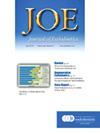成熟牙伴可逆性牙髓炎的龋髓暴露:直接髓盖和部分髓切开术的随机临床试验。
IF 3.6
2区 医学
Q1 DENTISTRY, ORAL SURGERY & MEDICINE
引用次数: 0
摘要
导言:没有明确的指导方针,以选择重要的牙髓治疗程序的牙髓暴露。本研究的目的是比较直接髓盖和部分髓切术对可逆牙髓炎的成熟恒牙的疗效。方法:采用平行双盲随机临床试验,选择成熟恒牙140颗。牙齿无症状或有可逆性牙髓炎症状,接受直接髓盖(n=67)或部分髓切开术(n=73)。术中经放大评估和止血后,放置NeoPUTTY MTA作为旋盖材料。记录基线变量。患者计划进行6个月和12个月的临床和影像学随访。采用卡方检验和回归分析对结果进行统计学比较。结果:大约一半的牙齿(74/140)出现症状,两组术前疼痛水平无显著差异(p=0.75),两种治疗方法在1周后疼痛均显著减轻(结论:根据术中对暴露牙髓的评估,直接盖髓或部分切髓均可成功治疗可逆性牙髓炎牙齿的牙髓龋露。本文章由计算机程序翻译,如有差异,请以英文原文为准。
Carious Pulp Exposure in Mature Teeth With Reversible Pulpitis: A Randomized Clinical Trial of Direct Pulp Capping and Partial Pulpotomy
Introduction
No clear guidelines exist for the selection of vital pulp therapy procedures in carious pulp exposures. This study aimed to compare the outcomes of direct pulp capping and partial pulpotomy in mature permanent teeth with reversible pulpitis.
Methods
The study was a parallel double-blind randomized clinical trial of 140 mature permanent teeth. Teeth were asymptomatic or with symptoms of reversible pulpitis and received direct pulp capping (n = 67) or partial pulpotomy (n = 73). After intraoperative assessment under magnification and hemostasis, NeoPUTTY (Avalon Biomed, Bradenton, FL) was placed as the capping material. Baseline variables were recorded. Patients were scheduled for 6- and 12-month clinical and radiographic follow-up. Results were statistically compared using chi-square tests and regression analysis.
Results
Approximately half of the teeth (74/140) were symptomatic, with no significant difference in the preoperative pain levels between the 2 groups (P = .75), both treatments resulted in significant pain reduction after 1 week (P < .001). After 6 months, 4 cases of partial pulpotomy and 10 cases of direct pulp capping failed; the success rate was 94.4% versus 84.4%, P = .057 respectively. At 1 year, 2 additional failures occurred in each treatment group with success rates of 91.5% for partial pulpotomy and 81.3% for direct pulp capping (P = .08). There were no significant prognostic factors for pulp capping or partial pulpotomy, multivariate analysis did not reveal any significant interactions.
Conclusions
Carious pulp exposure in teeth with reversible pulpitis can be managed successfully by either direct pulp capping or partial pulpotomy depending on the intraoperative assessment of the exposed pulp.
求助全文
通过发布文献求助,成功后即可免费获取论文全文。
去求助
来源期刊

Journal of endodontics
医学-牙科与口腔外科
CiteScore
8.80
自引率
9.50%
发文量
224
审稿时长
42 days
期刊介绍:
The Journal of Endodontics, the official journal of the American Association of Endodontists, publishes scientific articles, case reports and comparison studies evaluating materials and methods of pulp conservation and endodontic treatment. Endodontists and general dentists can learn about new concepts in root canal treatment and the latest advances in techniques and instrumentation in the one journal that helps them keep pace with rapid changes in this field.
 求助内容:
求助内容: 应助结果提醒方式:
应助结果提醒方式:


